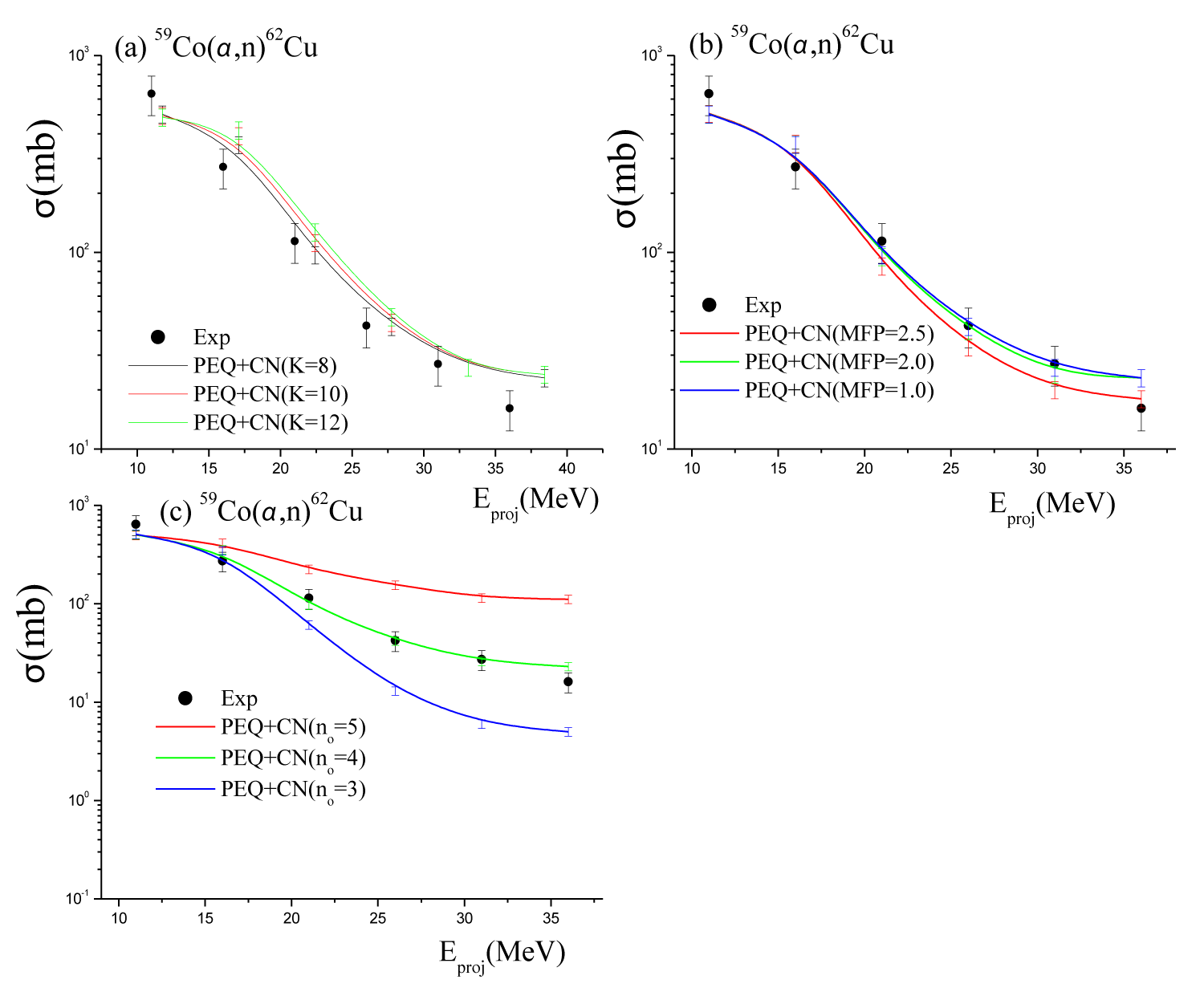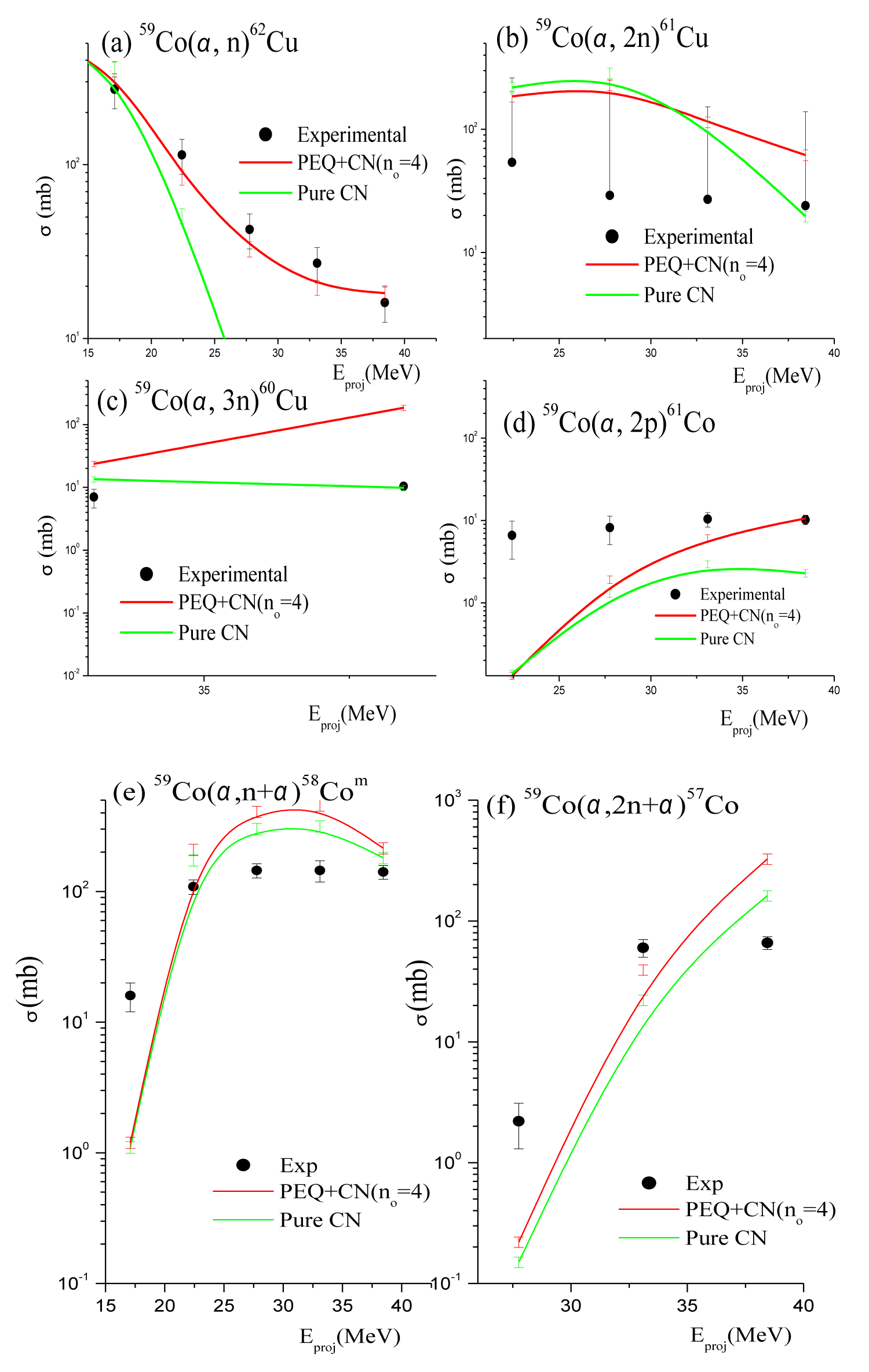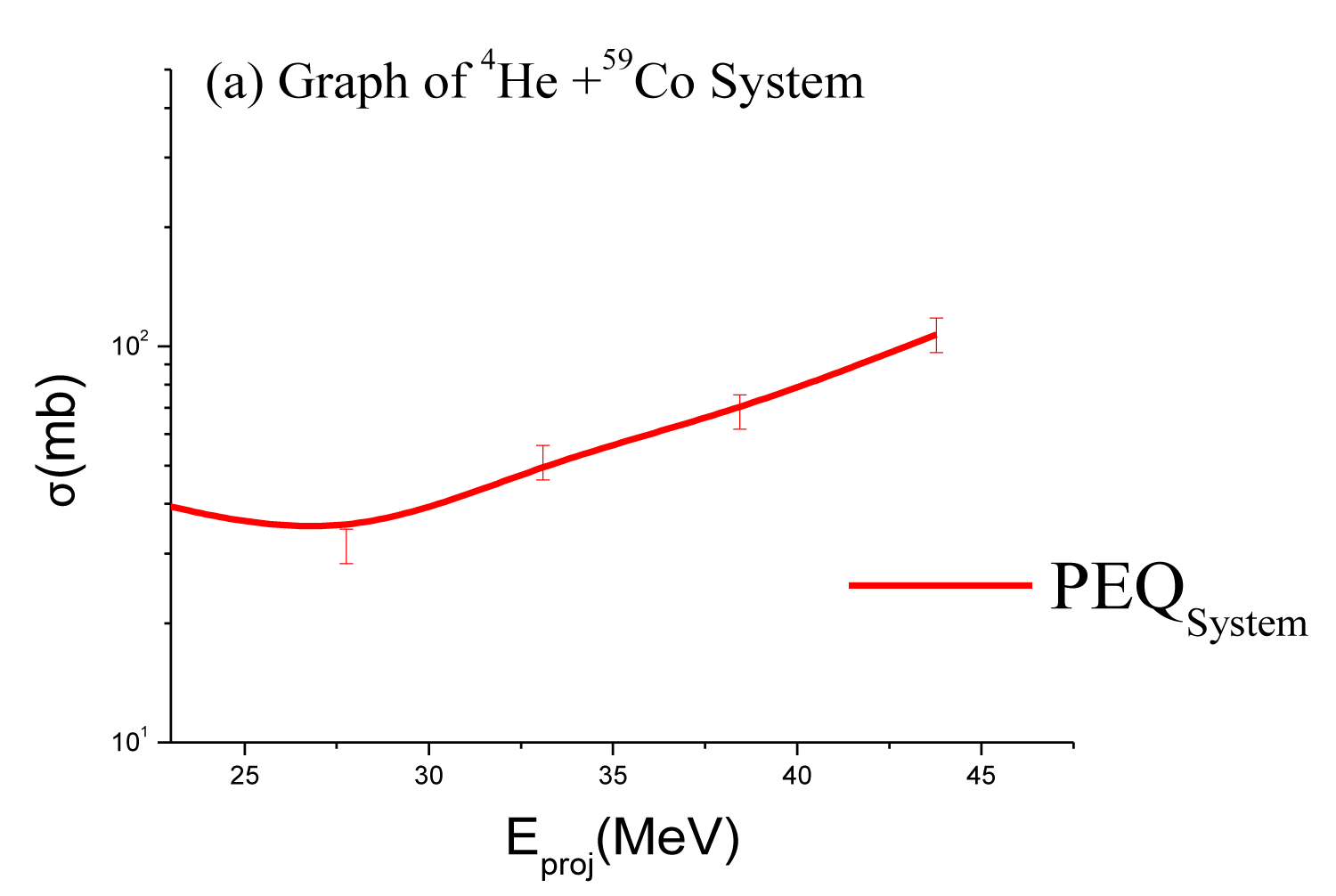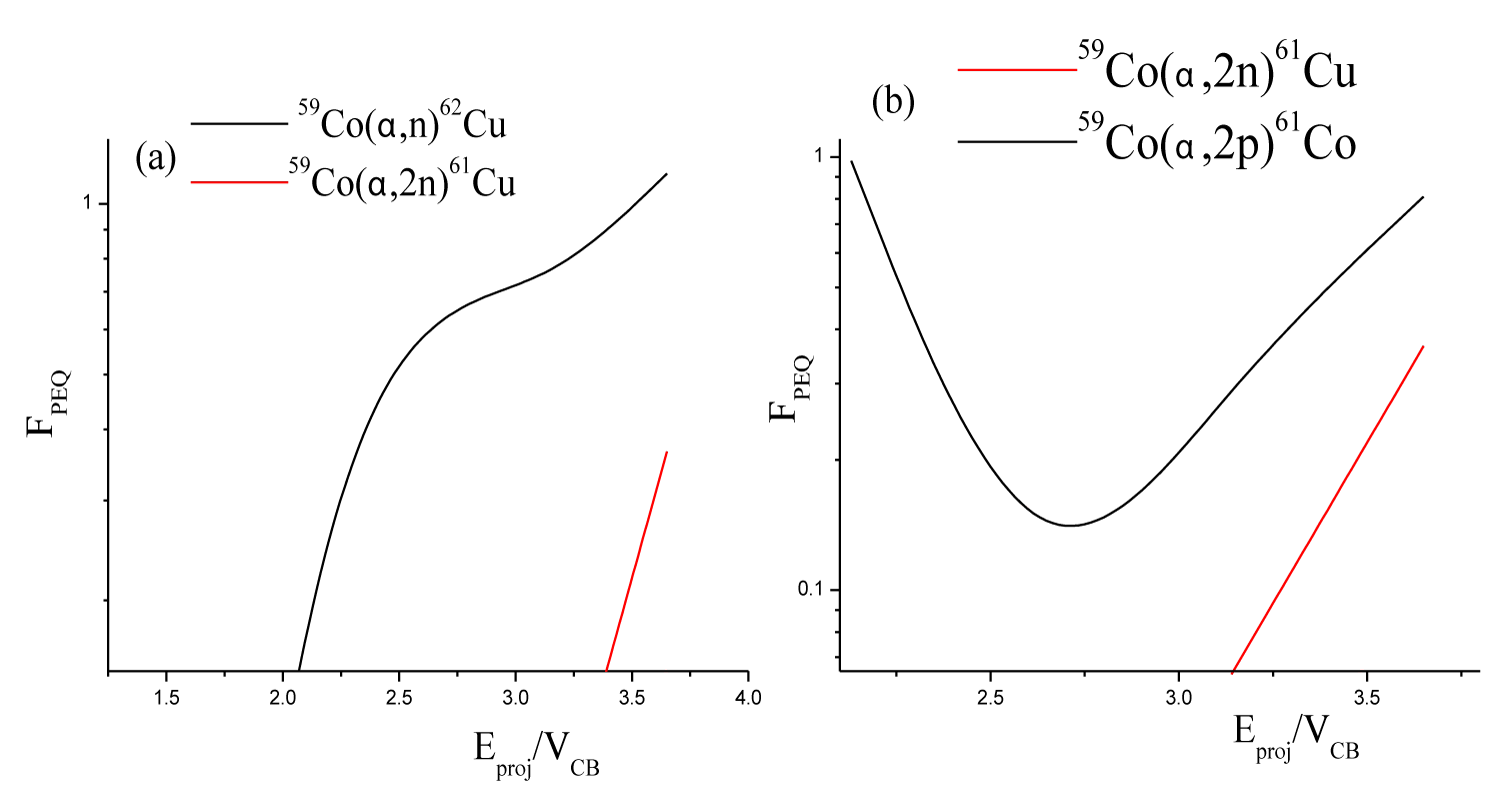More Information
Submitted: December 21, 2021 | Approved: February 28, 2022 | Published: March 01, 2022
How to cite this article: Bekele AB. A Study of excitation functions in the interaction of α + 59Co system at 4~9MeV/Nucleon. Int J Phys Res Appl. 2022; 5: 011-015.
DOI: 10.29328/journal.ijpra.1001044
Copyright License: © 2022 Bekele AB. This is an open access article distributed under the Creative Commons Attribution License, which peRmits unrestricted use, distribution, and reproduction in any medium, provided the original work is properly cited.
Acronym: IAEA, EXFOR: International Atomic Energy Agency Exchange Format; COMPLETE Code: Projection Angular Momentum Coupled Evaporation Monte Carlo Code
A Study of excitation functions in the interaction of α + 59Co system at 4~9MeV/Nucleon
Abraham Barena Bekele*
Department of Natural and Computational Sciences, Dawro-Tarcha Campus, Wolaita Sodo University, Ethiopia
*Address for Correspondence: Abraham Barena Bekele, Department of Natural and Computational Sciences, Dawro-Tarcha Campus, Wolaita Sodo University, Ethiopia, Email: [email protected]
In this work, α-induced 59Co reactions in the energy range from 11- 41MeV were used in order to study the role of pre-equilibrium emission. The experimentally measured excitation functions for residues populated via (α, n),(α, 2n),(α,3n),(α,2p),(α, 3n 2p) and (α, 4n 2p) channels in the interaction of + 59Co system available in the literature [13] were compared with theoretical predictions obtained using the statistical model code COMPLET. It was observed that at higher energy points the pure compound nucleus predictions, in general, failed to reproduce the measured data at projectile energies ~11-41MeV, this shows significant contributions from pre-equilibrium emission. The study signified both equilibrium and pre-equilibrium emissions were required to reproduce the presently measured excitation functions.
An attempt was made to deduce the contribution coming from pre-equilibrium emission. It was found that the pre-equilibrium contribution increases with increasing projectile energy. Furthermore, the present result revealed a strong correlation between pre-equilibrium contribution and particle multiplicity.
The study of nuclear reaction induced by alpha particles has been got a significant result for reaction cross-section [5]. The investigation of characters of atomic nuclei and the fundamental physical relationships governing their interactions was the basis for all nuclear technologies [6]. A nuclear reaction refers to the process of producing new nuclei and elementary particles as particles and nuclei interact [7]. This is why accurate measurement and calculation of the cross-section of nuclear reactions, and understanding of nuclear reaction mechanisms, are important. The reaction mechanisms are seen from the shape of the difference in reaction cross-section or excitation energy [8]. Cobalt is a transition metal with atomic number 27 and is used in electroplating because of its appearance, hardness, and resistance to oxidation [11]. One important part of studying such reactions is to enhance a basic understanding of the reaction mechanism. The mechanism of nucleon-induced reactions, particularly proton-induced reactions is still unclear [9]. At moderate excitation energies, there are indications that compound and pre-compound reaction processes play an important role [10]. Nuclear data for accelerator-driven technologies is required for a large number of target elements covering almost the entire periodic table and covering a wide range of energies [16]. Well, more detailed and accurate measurements are needed to achieve this data requirement. The nuclear data required for these applications is primarily obtained by nuclear scattering and reaction forecasting. The nuclear data required for these applications are mainly obtained from nuclear scattering and reaction model calculations, which are depending on the optical model, the parameters of which are determined by elastic scattering and total cross-section data [12]. The process of pre-equilibrium emission in light ion-induced reactions is a subject extensively studied in the last few years. Although there have been many theoretical and experimental works on nuclear physics, the process is still not fully understood, particularly where competition between the equilibrium and pre-equilibrium emission of light particles is high [13]. Accelerators were used to produce isotopes by bombarding appropriate targets with beams of charged nuclei, so impinge on the targets to produce the required isotopes [14]. The main aim of this work is was to have a unitary analysis of the nuclear reaction mechanisms causing alpha interactions with 59Co target nuclei [15]. The alpha particle was found by accident during the natural radioactive decay of heavy mass nuclei. Even after that, a large number of heavy mass-particle emitting radionuclides that were synthesized artificially were characterized. Their half-lives vary widely, but the-particle energies are usually between 4 and 7 MeV [17]. For all investigated, thick target production yields were used in the new cross-sections [18]. From which exchange format database were all available data for charged particle induced reactions, up to incident particle energy of 11 MeV to 41 MeV, used in the production of Cu and Co isotopes collected [21]. The energy of alpha particles obtained from natural radioactive nuclei is dispersed to all parts and discrete in nature, and it is significantly smaller than the coulomb barrier, making it unfit for the nuclear reaction [19]. Alpha particles were made up of two protons and two neutrons, so they have the structure of helium (4He) nuclei [20]. The shape of the difference of reaction cross-section versus excitation energy reveals the reaction mechanisms [4].
The study of this research was conducted mixed methods that mean quantitative with qualitative approach using computer base COMPLETE code software. The data was gathered (obtained) from an IAEA data source in searching google engine. The experimental data information was generated by the bombarded projectile as an alpha particle with target nuclide different cobalt isotopes using a COMPLETE computer-based software package.
OMPLETE code
COMPLETE code was a nuclear reaction code that was designed for versatility and easy use in the incident energy range of a few MeV to several hundred MeV [1]. The code COMPLETE generate yield and spectra for all reactions produced by all combination of n,p,d, T, α and can provide all input parameters. The running time of the COMPLETE code was very short times [3]. Its version needed about 2-megabyte memory. It also used determined p-spectra, n-spectra, pre-equilibrium, neutron-proton alpha emission up to two particles, evaporation of deuterium and tritium [2].
Experimental calculation using computer code
The software program run the input and output directory were defined. Alpha particle was preferable as incident particle followed by selecting target nuclide. The number of incident energy was specified followed by the first incident energy, the incident energy step is available. For practical applications of the statical model was important to obtain parameters of the level density description from a reliable experiment [4]. In compound and pre-equilibrium emission calculations, the level density parameter and initial excitation configurations were important quantities. The reaction cross section both compound and the pre-compound reaction was measured by mill barn (MB). The nuclear level density affects the height and the shape of the calculated cross-section. The level density of the nucleus is included in the evaporation chain calculated from the Fermi density distribution.
(1)
Where:
E - is the excitation energy
α - is the level density parameter.
The mean free path parameter calculation in pre-equilibrium was given by
(2)
ρ - is the level density of nuclear matter
σο - is Pauli corrected nucleon-nucleon (N-N) interaction the scattering cross-section appropriated weighted for target neutron and proton number.
The level density parameter obtained by the experiment showed that a linear dependent with the mass number of the nucleus was given by
(3)
Where
CAN – is the mass of the compound nucleus
K - is free path constant
This thesis work used level density parameters
(4)
(5)
Where:
- is reduced de Broglie wavelength
L - is angular momentum
- is the real part of the complex constant which contains the effect of the scattering center.
The present thesis investigates the excitation functions of 59Co(α, n)62Cu, 59Co(α, 2n)61Cu, 59Co(α, 3n)60Cu, 59Co(α, 2p)61Co, 59Co(α, 3n 2p)58Com and 59Co(α, 4n 2p)57Co reaction channels populated in the interaction of 4He projectile with 59Co target at ~11-41 MeV projectile energy. The measured excitation functions available in the literature were compared with the theoretical predictions obtained from the COMPLET code (modified ALICE-91). The COMPLET code gives the results of both equilibrium (CN) reaction and pre-equilibrium (PEQ) reaction. Level densities of residual nuclei play an important role in deciding the shapes and absolute value of the excitation functions. In COMPLET code the level density parameter a, which largely affects the equilibrium components of the cross-section is calculated from the expression a = A/K MeV−1, where A is the nucleon number of a compound system and K is an adjustable constant, which may be varied to match the experimental data. Also in this code, the pre-equilibrium components of the cross-section are sensitive to initial exciton configuration, no, and mean free path multiplier, MFM. The sensitivity of the initial exciton number on PE cross-section was done by varying the initial exciton configuration, no (n+p+h) which is described by the number of neutrons (n) and by the number of a proton (p) in excited states, and the number of holes (h) following the first interaction of a projectile with a target. The total exciton, no is equal to the sum of n, p, and h.
Production of cupper residues
The measured excitation functions were compared with complete code predictions for different level density parameter values for representative 62Cu evaporation residue produced in the interaction of the 4He + 59Co system. For the representative 62Cu evaporation residues, the value of K was varied to match the experimental data (K values of 8, 10, and 12 were used) and the results are displayed in Figure 1a. To see the effects of mean free path multiplier (MFM), which is used to adjust the nucleon-nucleon mean free path inside the composite excited nucleus was varied from 1 to 2.5. It may be observed from Figure 1b that a value of mean free path multiplier (MFM = 1.0) reproduced satisfactorily the measured excitation functions. Similarly the values of the initial exciton number, no was varied from 3 to 5. As can be seen from Figure 1c the measured excitation function for the same representative channel is well reproduced by COMPLET for a value initial exciton number (no = 4).
Figure 1: Experimentally measured data obtained from EXFOR data source and theoretically calculated excitation functions for evaporation residues produced in 4He + 59Co reaction using the code COMPLET.
Figure 2 b,c, displayed the measured excitation functions along with the COMPLET code predictions of 61Cu and 60Cu residues populated via (α, 2n) and (α, 3n) channels respectively at the set values of input parameters (K = 8, no = 4, and MFM = 1.0).
Figure 2: Experimentally measured data obtained from EXFOR data source IAEA and theoretically calculated excitation functions for different evaporation residues produced in the 4He + 59Co reaction using the code COMPLET.
In the present work, all calculations and analysis were performed consistently using level density (K = 8), initial exciton number (no = 4), and mean free path multiplier (MFM = 1.0).
Production of copper residues
The measured excitation functions along with the COM-PLET predictions for 61Co, 58Co, and57Co residues populated via (α, 2p),(α, 3n 2p) and (α, 4n 2p) channels are shown in Figure 2 d-f. It may be observed from Figure 2 that at higher energy points the theoretically calculated excitation functions corresponding to the level density K = 8, the mean free path multiplier MFM = 1.0 and the initial exciton number no = 4, in general, reproduced satisfactorily the experimentally measured excitation functions for the residues 61Co, 58Co, and 57Co produced in the interaction of α - projectile with 59Co target. Further, it is clear from Figure 2 that at lower energy points the predictions do not satisfactorily reproduce the measured data.
For a better analysis of the experimental data, the code COMPLET (modified ALICE-91) is frequently used. This may be attributed to the fact that the input parameters of the code are few and well-defined. It may further point out that the measured data set is well fitted with the prediction of the code COMPLET. In general, it is clear from Figure 2 that the PEQ emission is significantly observed in most channels of the present study. Thus, an asymmetric attempt has been made to estimate the PEQ contribution at given energy for a particular reaction channel and these could be well explained in section Figure 3.
Figure 3: Pre-equilibrium emission for 4He + 59Co (total) system as a function of projectile energy.
Pre-equilibrium contributions
To study the dependence of PEQ contribution on projectile energy, the percentage PEQ contribution, which is a measure of the relative strength of PEQ component needed to reproduce the measured cross-section, defined as the ratio of the PEQ cross-section, σPEQ (σPEQ = σexp - σCN) to the experimental cross-section, σexp.
The percentage PEQ contribution as a function of normalized projectile energy (Epoj/VCB) for α + 59Co system through the six channels discussed above is plotted in Figure 3. In general, it is clearly seen from Figure 3 that the percentage of the PEQ contribution is found to increase smoothly with normalized projectile energy.
Figure 4 a,b display the PEQ contributions of (α, n), (α, 2n), and (α, 2p) channels as a function of projectile energy. It may be observed from Figure 4 the channel-based contribution of PEQ emission, in general, is found to increase with projectile energy. Furthermore, the threshold of PEQ emission for (α, n), (α, 2n), and (α, 2p) channels is found to be different, depending on the corresponding Q - value.
Figure 4: Pre-equilibrium fraction for different channels as a function of normalized projectile energy in 4He + 59Co system.
The Coulomb barrier tends to cut off the low-energy portion of proton spectra thus reducing the number of equilibrium protons.
However, it may be pointed out that the PEQ contribution is found to be greater for the channels that consist of fewer PEQ particle(s). This may be attributable to the probability of the single-particle emission is greater in the PEQ emission process.
In the present work, a study of the excitation function in the interaction of alpha on cobalt atom for the energy range of 4~9MeV/nucleon was studied by using an excitation model with an improved computer COMPLETE code software. As a result of this, the compound nucleus was occurred through the de-excitation of selected nuclei by emitting one neutron, two neutrons, three neutrons, and two protons using the fitting level density parameter. In alpha-induced reaction with cobalt isotope 62Cu, 61Cu, 60Cu, 61Co, 58Com, and 57Co were produced. During the study of the reaction compound and pre-equilibrium reaction were occurred but a direct reaction was almost not expected. Direct reaction is required to a very large amount of energy. The level density parameter and initial excitation configuration were targeted quantities for the pre-equilibrium and compound reaction. It should be further pointed out that a set of level density (K = 8), exciton number (no = 4) with mean free path (MFM = 1.0) is found to give a satisfactory reproduction of the theoretical calculation. The pre-compound reaction was depended on the projectile energy and target mass. Thus, the reaction was occurred at high energy but at low energy range not significant. Even though projectile energy very low compound nucleus might have occurred.
Availability of data and materials
The present work is totally my idea without considering citation of reference which means that there was no conflict of interest among the researchers. Theoretical data tool from IAEA, EXFOR data and to generate experimental data COMPLETE code is used.
Authors’ contributions
Research article conceived and designed the study. The Author has done study validation, formal analysis, investigation resources, reaction mechanism and more gave attention to research to the nuclear science technology.
First of all, I would like to thank the “Almighty God”, for accomplishing and successive my work. Next, I would like to thank my Wife Nigatuwa Alemayehu and my daughter Hilina Abraham who helped me by providing valuable, moral, and material support. Finally, I wish to forward my profound thanks to all my friends and relatives whose wishes were great for my academic success.
- Nigussie B. Complete and incomplete fusion studies in some 14N+59Co systems, Addis Ababa University. 2012.
- Prajapati PM, Mukherjee S, Naik H, Goswami A, Suryanarayana SV, et al. Measurement of neutron-induced reaction cross-sections in zirconium isotopes at thermal, 2.45MeV and 9.85MeV energies. Nucl Sci Eng. 2012; 171: 78-84.
- Hodgson PE, Gadioliand E. Industry Nuclear physics, Oxford University Press. 2003.
- Zinabe B. Investigation of alpha induced Reaction on Copper Isotopes for Energy Range of 15-50MeV, Mekdela Amba University.
- IAEA (2007-2017), Nuclear Data Services.
- Ali A. Neutron Physics, Addis Ababa, Ethiopia June. 2011.
- Tadesse A The study of α_ Particle induced reaction on gallium isotopes Addis Ababa University. 2007.
- Lobo N. Study of 20Ne induced reaction in 59Co, Incomplete and complete fusion. Addis Ababa University. 2016.
- Ayele G. Study of proton induced reaction - cross section for various energies on yttrium and scandium, Addis Ababa University. 2007.
- Moiseeva AN, Aliev RA, Unezhev VN, Zagryadskiy VA, Latushkin ST, et al. Cross section measurements of 151Eu (3He, 5n) reaction: new opportunities for medical alpha emitter 149 Tb production. 2020; 10-508.
- Asabella AN, Cascini GL, Altini C, Paparella D, Notaristefano A, et al. Retracted: The Copper Radioisotopes: A Systematic Review with Special Interest to 64Cu. Bio Med Res Int. 2018; 9. PubMed: https://pubmed.ncbi.nlm.nih.gov/24895611/
- Singh BP, Musthafa M, Bhardwaj H, Singh DP, Singh PP, et al. A study of pre-equilibrium emission in some proton induced reactions: Measurement of cross-sections. Radiation effect on space electronics and devices. 2014.
- Amanuel FK, Zelalem B, Chaubey AK, Agarwal A, Rizvi IA, et al. Significant Amount of Pre-Equilibrium Contribution in the α + 93 Nb System at Energies 18–40 MeV. Complete and Incomplete fusion in heavy ion induced reactions. 2011; 49.
- Maher NN. Cross sections and yields calculations for copper-64 production induced by deuterons and protons. Int J Phys. 2013; 3: 13-20.
- Avrigeanu M, Avrigeanu V. Assessment of deuteron-induced reaction mechanisms at low and medium energies. EPJWeb of Conferences, Bucharest, Romania. 2010.
- Aydın EG, Tel E, Kaplan A, Aydın A. Equilibrium and pre-equilibrium calculations of neutron production in medium–heavy targets irradiated by protons up to 100 MeV. Ann Nucl Energy. 2008. 35: 2306–2312.
- Qaim SM, Spahn I, Scholten B, Neumaier B, Uses of alpha particles, especially in nuclear reaction studies and medical radio nuclide production. Radiochim. Acta Germany. 2016; 104: 601–624.
- Tárkányi F, Hermanne A, Ditrói F, Takács S, Ignatyuk AV, et al. Activation cross section data of deuteron induced nuclear reactions on rubidium up to 50 MeV. Eur Phys JA. 2021; 57.
- Mechalo MG. Theoretical Calculation of Reaction Cross-section Induced by Alpha Particle on Zinc Isotopes (64Zn, 66Zn) below 46MeV. Research articles. 2018.
- Grzywa-Celińska A, Krusiński A, Mazur J, Szewczyk K, Kozak K. Radon the Element of Risk. The Impact of Radon Exposure on Human Health. 2020; 8: 120. PubMed: https://pubmed.ncbi.nlm.nih.gov/33327615/
- https://en.wikipedia.org › wiki › Cobalt



